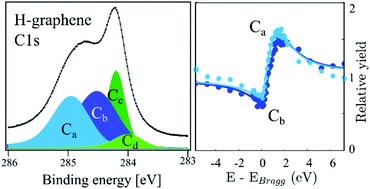Selective hydrogenation of graphene on Ir(111): an X-ray standing wave study
Abstract
A combined high resolution X-ray photoelectron spectroscopy and X-ray standing wave study into the adsorption structure of hydrogenated graphene on Ir(111) is presented. By exploiting the unique absorption profiles and significant modulations in signal intensity found within the X-ray standing wave results, we refine the fitting of the C 1s X-ray photoelectron spectra, allowing us to disentangle the contributions from hydrogenation of graphene in different high-symmetry regions of the moiré supercell. We clearly demonstrate that hydrogenation in the FCC regions results in the formation of a graphane-like structure, giving a standalone component that is separated from the component assigned to the similar structure in the HCP regions. The contribution from dimer structures in the ATOP regions is found to be minor or negligible. This is in contrast to the previous findings where a dimer structure was assumed to contribute significantly to the sp3 part of the C 1s spectra. The corrugation of the remaining pristine parts of the H-graphene is shown to increase with the H coverage, reflecting an increasing number and size of pinning centers of the graphene to the Ir(111) substrate with increasing H exposure.

- This article is part of the themed collection: Photoelectron spectroscopy and the future of surface analysis


 Please wait while we load your content...
Please wait while we load your content...